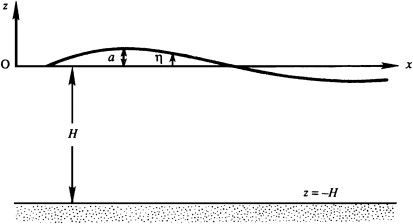
\(\because\) the equation for the surface \( f(x, z, t) = z - \eta(x, t) = 0 \)
\(\therefore\) the surface normal \( \mathbf{n} \) points upward out of the liquid \(\mathbf{n} = \nabla f / |\nabla f| = \left( -(\partial \eta / \partial x) \mathbf{e}_x + \mathbf{e}_z \right) / \sqrt{ (\partial \eta / \partial x)^2 + 1 }\)
the velocity of the surface \( \mathbf{u}_s \) at any location \( x \) can be considered purely vertical \(\mathbf{u}_s = (\partial \eta / \partial t) \mathbf{e}_z\)
\(\therefore\) \((\mathbf{n} \cdot \mathbf{u})_{z = \eta} = \mathbf{n} \cdot \mathbf{u}_s\) times \( |\nabla f| \Rightarrow\) \( (\nabla f \cdot \mathbf{u})_{z = \eta} = \nabla f \cdot \mathbf{u}_s \)
\(\because\) \(\mathbf{u}_s = (\partial \eta / \partial t) \mathbf{e}_z\), \( \mathbf{u} = u \mathbf{e}_x + w \mathbf{e}_z \), \(
u = \partial \phi / \partial x,
w = \partial \phi / \partial z
\)
\(\therefore\) \(\left( -u \frac{\partial \eta}{\partial x} + w \right)_{z = \eta} = \frac{\partial \eta}{\partial t} \text{ or } \left( \frac{\partial \phi}{\partial z} \right)_{z = \eta} = \frac{\partial \eta}{\partial t} + \left( \frac{\partial \eta}{\partial x} \right) \left( \frac{\partial \phi}{\partial x} \right)_{z = \eta}\)
\(\because\) For small slope waves, the \(\boxed{\left( \frac{\partial \eta}{\partial x} \right) \left( \frac{\partial \phi}{\partial x} \right)_{z = \eta}}\) is small compared to the other two terms
\(\therefore\) The kinematic boundary condition can be approximated \(\left( \frac{\partial \phi}{\partial z} \right)_{z = \eta} \cong \frac{\partial \eta}{\partial t}\)
\(\because\) For consistency, the left side of \(\boxed{\left( \frac{\partial \phi}{\partial z} \right)_{z = \eta}} \cong \frac{\partial \eta}{\partial t}\) must also be approximated for small wave slopes
\(\therefore\) Taylor series expansion around \( z = 0 \): \(\left( \frac{\partial \phi}{\partial z} \right)_{z = \eta} = \left( \frac{\partial \phi}{\partial z} \right)_{z = 0} + \eta \left( \frac{\partial^2 \phi}{\partial z^2} \right)_{z = 0} + \dots \cong \left( \frac{\partial \phi}{\partial z} \right)_{z = 0}\)
\(\therefore\) When \( a / \lambda \) is small enough, the most simplified version of \((\mathbf{n} \cdot \mathbf{u})_{z = \eta} = \mathbf{n} \cdot \mathbf{u}_s\) is
\(\boxed{
\left( \frac{\partial \phi}{\partial z} \right)_{z = 0} \cong \frac{\partial \eta}{\partial t}}
\)